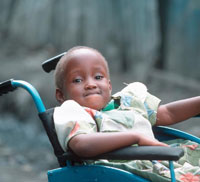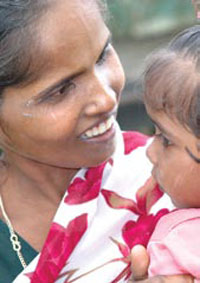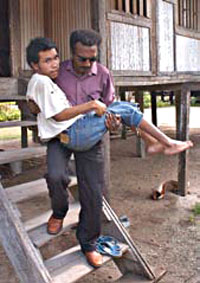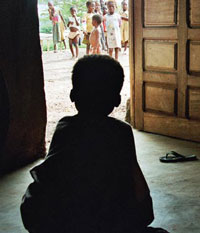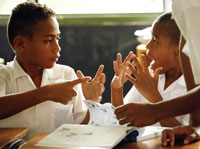Summary
This short publication summarises the strategy 'Development for All: Towards a disability-inclusive Australian aid program 2009-2014'.
Description
This short publication is a summary of the strategy Development for All: Towards a disability-inclusive Australian aid program 2009-2014.
This summary is also available in the following formats:
-
Development for All: Towards a disability-inclusive Australian aid program 2009-2014 (Strategy summary) [PDF 677kb]
- Development for All–Large print (Strategy summary) [PDF 227kb]
- Development for All–Large print (Strategy summary) [Word 419kb]
Disability and the aid program
'Development for All: Towards a disability-inclusive Australian aid program 2009–2014' sets out practical approaches to guide the Australian aid program in meeting the needs and priorities of people with disability. The strategy is aligned
with the Australian Government's national social inclusion agenda and reflects the commitment to extending the benefits of development to all and to promoting the dignity and well-being of people with disability.
People with disability are often among the poorest, most vulnerable and excluded members of developing countries. The UN estimates that approximately 10 per cent of the world's population, or around 650 million people, have a disability and about 80 per cent of the population with a disability live in developing countries. Disability and impairment in Asia and the Pacific are expected to increase over the coming decades as a result of population growth, ageing, lifestyle diseases (such as diabetes), conflict, malnutrition, traffic accidents, injuries, HIV, and medical
advances that preserve and prolong life.
The Development for All strategy responds to the reality that people with disability have often been excluded, even if unintentionally, in development processes and programs. The strategy has been developed through comprehensive consultations with people with disability and stakeholders in disability and development from across the Pacific, Asia and in Australia.
What we will do
Usha was blinded by cataract until recent surgery. Now she says, 'I am very happy to see again! I don't need to be led. I can walk on my own. I can take care of the household and my children.' Photo: India, Phil Lam, CBM/ADDC
The strategy's primary outcome is to support people
with disability to improve the quality of their lives by
better access to the same opportunities for participation,
contribution, decision-making, and social and economic
well-being as others. This will be achieved by supporting
national governments' efforts towards disability-inclusive
development, assisting Disabled People's Organisations
to strengthen their capacity to become effective advocates
in inclusive development, and building on existing
investments in the education and infrastructure sectors
of Australia's aid program towards improved access to
education and the built environment.
While most resources available under the strategy will be
directed towards improving the quality of lives of people
with disability, reducing preventable impairments was also
seen as a priority in consultations. Avoidable blindness
and road safety have been identified as initial areas where,
with careful investment, significant progress in reducing
impairments can be made.
Leadership in disability and development will be
strengthened by building the capacity of people with
disability and their organisations–proven advocates
for advancing the issues that affect them. Australia will
also develop its own international leadership capacity
in disability-inclusive development by modelling good
practice, forging strategic partnerships to leverage action,
and through leadership in international forums to raise the
profile of disability and development.
How we will work
Mobility can be
challenging in many
environments, but
communities can take
responsibility to include
people with disability
and support their needs.
With the help of Senta
Bilong Helpim volunteers
this boy and others get
the therapy they need
and a chance to get out
of their homes.
Photo: PNG, Rocky Roe,
AusAID/ADDC
How the aid program works is as important as what we do.
In line with the UN Convention on the Rights of Persons
with Disabilities, we have identified six principles to guide
AusAID's work. The overarching principle is to respect
and value the contribution and perspectives of people
with disability. People with disability will play an active
and central role in our work, including in monitoring and
evaluating our performance. In addition, we will promote
the rights and respect the diversity of people with disability,
take gender influences into account, focus on children and
promote people-to-people links and partnerships.
Towards inclusive development
By including people with disability in the development
process, recognising their potential, valuing and respecting
their contributions and perspectives, honouring their
dignity, and effectively responding to their needs,
this strategy will be part of the Government's broader
reorientation of the Australian aid program. Support for
people with disability will also work to reduce poverty and
hasten progress towards the Millennium Development
Goals, designed to improve the well-being of the world's
poorest people by 2015.
Core outcomes
1. Improved quality of life for people with disability
Focused and targeted
- comprehensive support for partner governments'
efforts towards disability-inclusive development
(in two countries initially)
Targeted sectoral focus across all country programs
- inclusive education and accessible infrastructure
Disability-specific initiatives
capacity development of disabled peoples'
organisations
Flexible support mechanisms for all countries
- NGO agreements, volunteers, research, leadership
awards and scholarships, sports and small grants
Fear and lack of knowledge mean that conditions such as this boy's epilepsy can become disabling, isolating them from community life. The impacts of impairments can be greatly reduced by changing attitudes and practices that create disability. Photo: Photo: Cote d'Ivoire, Marie Maroun,CBM/ADDC
2. Reduced preventable impairments
Preventable impairment-specific initiatives
- Avoidable Blindness Initiative to reduce the
incidence of preventable blindness and improve
the quality of life for people with low vision and
blindness - road safety to reduce the incidence of traffic
accidents that lead to death and disability and
to relieve the humanitarian, social and economic
burden of this global health issue
3. Effective leadership on disability and development
- support leadership of people with disability
- model good practice in disability inclusive
development - forge strategic partnerships to leverage action
- build political and senior agency leadership in
regional and international forums - strong Australian advocacy to increase the priority
on disability and development
Enabling outcomes
4. AusAID skilled and confident in disability-inclusive development
- strengthen AusAID's capacity to successfully promote, manage and monitor
disability-inclusive development as a central aspect of Australia's aid program - ensure AusAID is an open, accessible and inclusive organisation
5. Improved understanding of disability and development
- build strategic partnerships to strengthen efforts to capture robust quantitative
and qualitative data on disability, poverty and development with a strong focus
on the lived experiences of people with disability - strengthen knowledge management, coordination, dissemination, accessibility
and application
Guiding principles
School children learning sign language at the Fiji School of the Deaf. Alternative forms of communication can play a significant role in opening doors to education and employment. Photo: Rob Maccoll, AusAID
- Active central role by people with disability: Promote and enable active
participation and contributions by people with disability. - Recognise and respect rights: People with disability hold the same rights as
others. - Respect and understand diversity: The lived experiences and perspectives
of people with disability are diverse, and effective approaches for improving
outcomes will vary in different contexts. Better understanding of the lived
experience of people with disability will help break down the attitudes that
create and reinforce disability, and build respect for diversity. - Take into account the interaction of gender and disability: Inequality and
multiple forms of discrimination may be experienced by men and women, girls
and boys who are people with disability, family members and carers. - Focus on children: Children with disability face major barriers to enjoying the
same rights and freedoms as their peers and may often face greater risks of
abuse. - Support people-people links and promote partnerships: The combined
commitment, influence and experience of Disabled People's Organisations,
government, civil society, faith-based and Non-Government Organisations,
education and training institutions and the private sector will ensure effective
development inclusive of people with disability.

